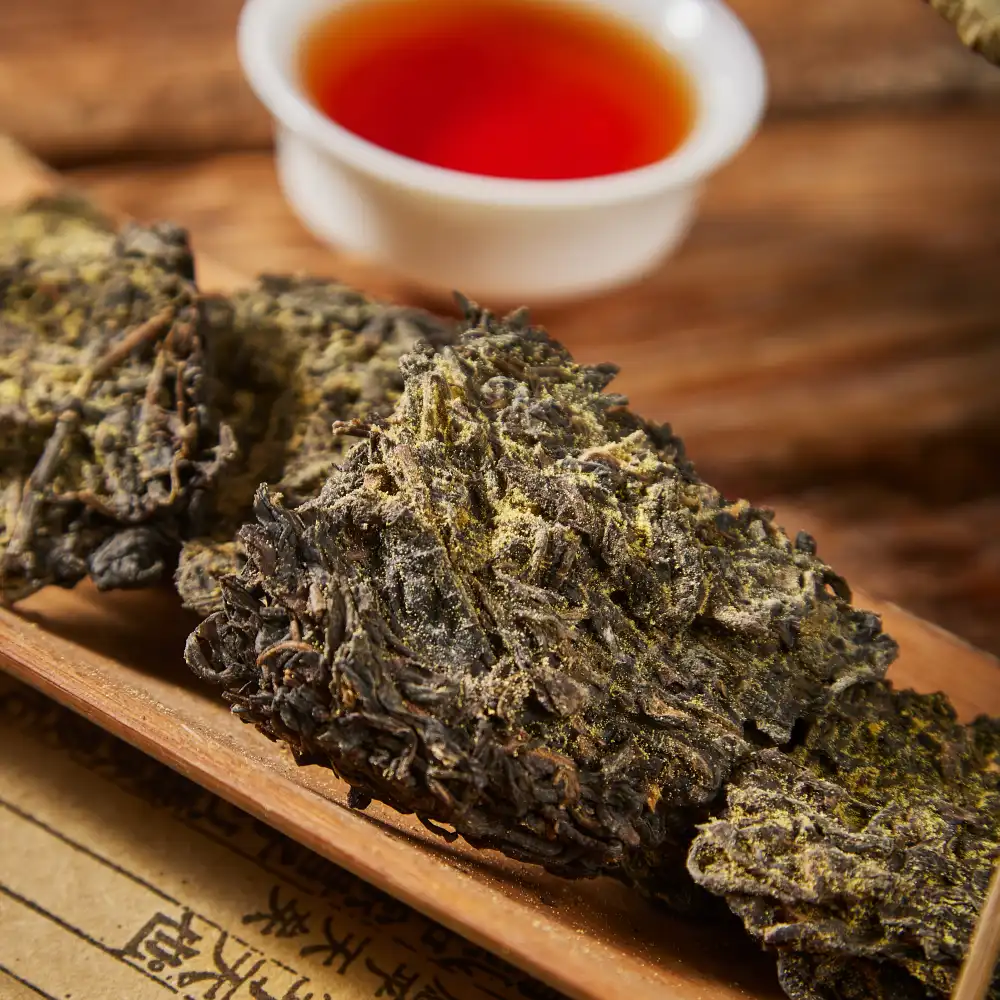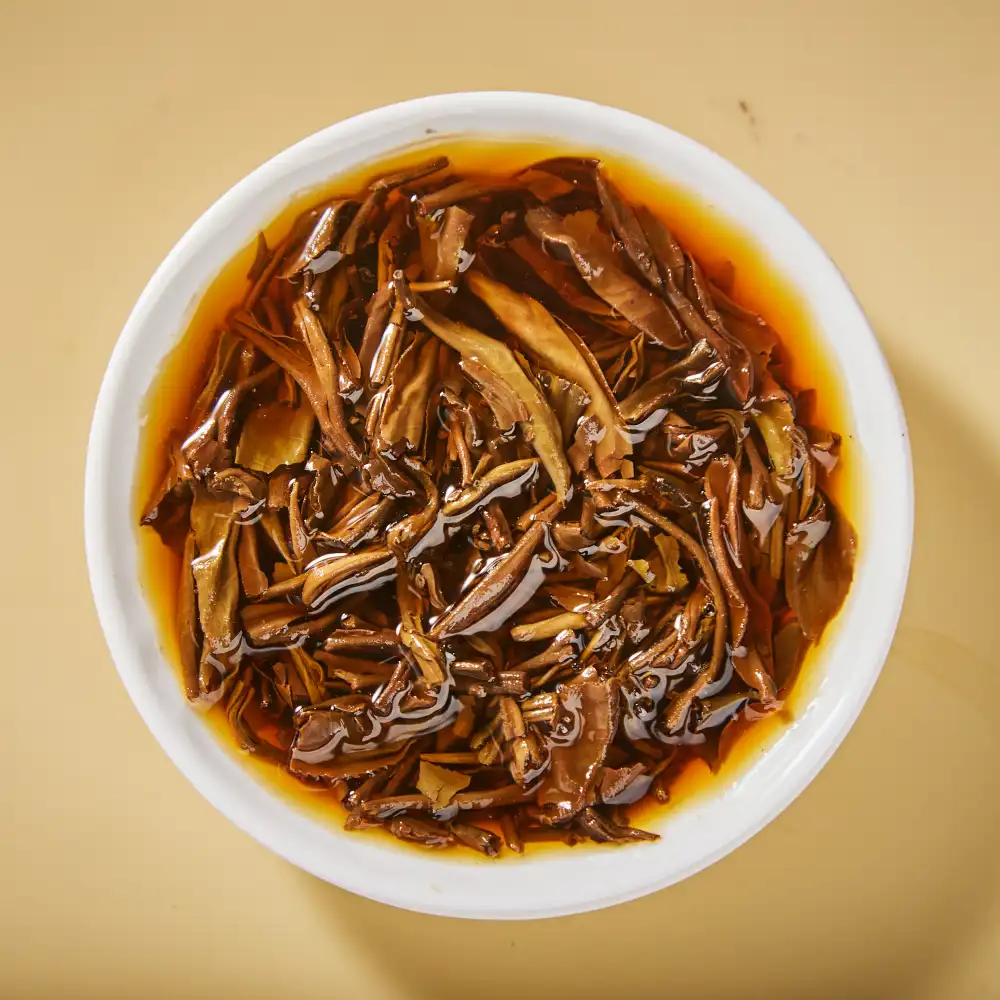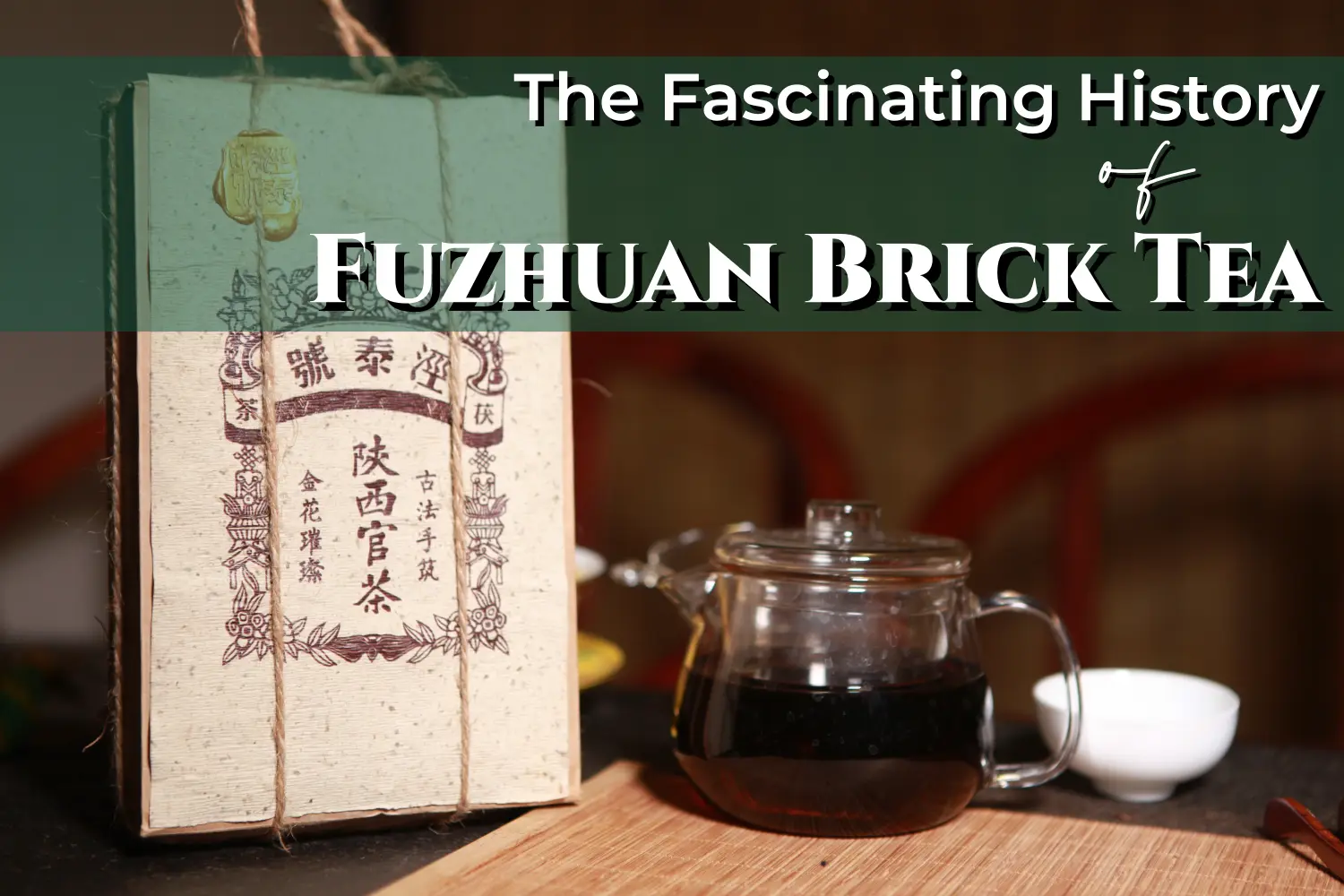Fuzhuan tea, also known as Fuzhuan brick tea, is a unique and fascinating variety of dark tea that has captivated enthusiasts for centuries.
With its rich history and complex flavors, this enigmatic brew has become integral to Chinese tea culture. Join us on a journey through time as we explore this remarkable tea’s origins, production methods, and cultural significance.
The Origins of Fuzhuan Tea: A Tale of Ancient Trade Routes
Fuzhuan tea has its roots in the Jingyang region of Shaanxi. Although this area, once close to China’s ancient capital, Chang’an (长安, now Xi’an), wasn’t originally famous for tea production, Fuzhuan tea emerged through a serendipitous discovery. Some tightly compressed tea leaves accidentally plummeted into the Jing River, where they began to ferment and cultivate the unique golden flower fungus. When people sampled this tea, they were pleasantly surprised by its enhanced flavor, which ultimately led to the creation of this distinctive tea variety.
However, it wasn’t until the Tang Dynasty (618-907 CE) that Fuzhuan tea rose as a particular assortment. During this period, tea became a fundamental product along the ancient Tea Horse Road, a network of exchange courses interfacing China with Tibet and other neighboring locales. The request for tea in these zones was monstrous, but transporting new tea took off over long separations and through challenging territories, which was demonstrated to be a noteworthy impediment.
Innovative tea makers developed a unique processing method to address this issue. This method would allow tea to be preserved for extended periods and withstand the rigors of long-distance travel. This method involved compressing tea leaves into dense bricks, which were easier to transport and store. Thus, Fuzhuan Brick Tea was born.
The name “Fuzhuan” offers a glimpse into the history of tea. “Fu” (茯) refers to the distinctive golden flowers that develop on the tea during its aging process, while “zhuan” (砖) means “brick,” alluding to its compressed form. This nomenclature perfectly encapsulates the unique characteristics that set Fuzhuan tea apart from other varieties.
The Art of Crafting Fuzhuan Brick Tea: A Time-Honored Tradition
The production of Fuzhuan tea is a meticulous process that has been refined over centuries. It begins with carefully selecting tea leaves, typically harvested from the Jingyang region of the Qinling Mountains. The leaves used are primarily from the large-leaf variety of Camellia sinensis, known for their robust flavor and ability to withstand intense processing.
Once harvested, the tea leaves undergo a series of complex steps:
- Fixation: The fresh leaves are quickly heated to halt oxidation and preserve their natural qualities.
- Rolling: The leaves are then rolled to break down their cellular structure and release essential oils.
- Pile Fermentation: This crucial step involves piling the leaves and allowing them to ferment under controlled conditions. Depending on the desired flavor profile, this process can last 10 to 60 days.
- Steaming: The fermented leaves are steamed to soften and prepare them for compression.
- Molding: The softened leaves are pressed into molds, forming the characteristic brick shape of Fuzhuan tea.
- Drying: The tea bricks are dried to remove excess moisture and stabilize their form.
- Aging: Finally, the tea bricks are aged for several months to several years, allowing them to develop unique flavors and distinctive golden flowers.
The golden flowers, scientifically known as Eurotium cristatum, are a type of beneficial fungus that naturally develops on the surface of the tea during aging. Far from being a defect, these golden spores are highly prized for their potential health benefits and the unique flavor they impart to the tea. The entire production process of Fuzhuan brick tea is a testament to the ingenuity and expertise of Chinese tea makers. It perfectly balances traditional techniques and natural methods, producing a proper tea.
Fuzhuan Tea in Modern Times: A Cultural Icon and Health Elixir


- Fuzhuan brick tea has a smooth, mellow taste with earthy and sweet hints.
- Traditionally prepared by breaking off a piece of the brick and steeping it.
- It is believed to aid digestion, boost metabolism, and promote well-being.
- Golden flowers in the tea may offer antioxidant and cholesterol-lowering effects.
- Fuzhuan tea’s global popularity is growing, with increasing appreciation for its history and flavors.
While Fuzhuan brick tea originated as a practical solution for tea transportation, it has evolved into much more than that today. Its unique flavor profile, characterized by a smooth, mellow taste with hints of earthiness and a subtle sweetness, has won it a dedicated following among tea connoisseurs worldwide. In China, Fuzhuan tea holds a special place in the pantheon of traditional teas. The tea is traditionally prepared by breaking off a small piece of the brick, which is then steeped in hot water. Some enthusiasts, like fine wines, even age their Fuzhuan tea bricks for years to develop more complex flavors.
Beyond its cultural significance, Fuzhuan brick tea has garnered attention for its potential health benefits. Traditional Chinese medicine has long valued this tea’s purported ability to aid digestion, boost metabolism, and promote overall well-being. Modern scientific research has begun to explore these claims, with some studies suggesting that Fuzhuan tea may offer certain health advantages due to its unique composition and fermentation process.
The golden flowers in Fuzhuan tea have been a particular focus of scientific interest. Some research indicates that these fungi may contribute to the tea’s antioxidant properties and potential cholesterol-lowering effects. However, it’s important to note that more comprehensive studies are needed to fully understand and validate these health claims.
In recent years, the global popularity of Fuzhuan brick tea has been on the rise. Tea enthusiasts worldwide are discovering this ancient brew’s unique charms, leading to increased demand and a growing appreciation for its rich history and complex flavors. This resurgence has also sparked renewed interest in traditional tea production methods and the cultural heritage associated with teas like Fuzhuan.
Conclusion
As we look to the future, it’s clear that Fuzhuan brick tea will continue to play an important role in the world of tea. Its enduring popularity is a testament to the timeless appeal of well-crafted, traditionally produced teas. Fuzhuan tea offers a fascinating journey into history, culture, and flavor for those seeking to explore the vast and varied landscape of Chinese teas.
Whether you’re a seasoned tea aficionado or a curious newcomer, experiencing Fuzhuan brick tea is like taking a sip of living history. Each cup tells a story of ancient trade routes, time-honored craftsmanship, and the human desire to create something extraordinary. So the next time you’re in the mood for a tea adventure, consider reaching for a piece of Fuzhuan brick tea and immerse yourself in its rich, storied past.
We serve thousands of satisfied tea enthusiasts in our tea house each year, and we’re excited to share these exceptional teas with tea lovers worldwide at Orientaleaf.com.

References
- Zhang, L., et al. (2013). Fuzhuan Brick Tea: A Review of the Traditional Processing Method and Recent Advances. Journal of Agricultural and Food Chemistry, 61(36), 8574-8584.
- Ling, T. J., et al. (2010). New Triterpenoids and Other Constituents from a Special Microbial-Fermented Tea—Fuzhuan Brick Tea. Journal of Agricultural and Food Chemistry, 58(8), 4945-4950.
- Liu, Z., et al. (2011). The effects of Fuzhuan brick-tea water extract on nutrient metabolism and serum lipid profile in rats. Journal of the Science of Food and Agriculture, 91(4), 710-715.
- Xie, M., et al. (2013). A review of the effect of traditional Chinese medicine on gut microbiota: A focus on Fuzhuan brick tea. Evidence-Based Complementary and Alternative Medicine, 2013.
- Peng, C., et al. (2014). Chemical composition, antimicrobial property and microencapsulation of Mustard (Sinapis alba) seed essential oil by complex coacervation. Food Chemistry, 165, 560-568.


